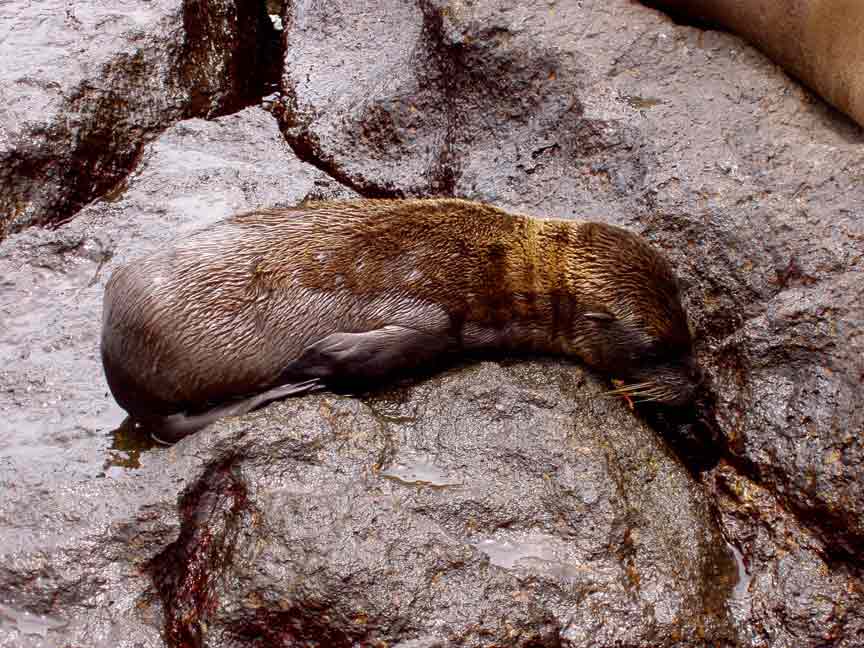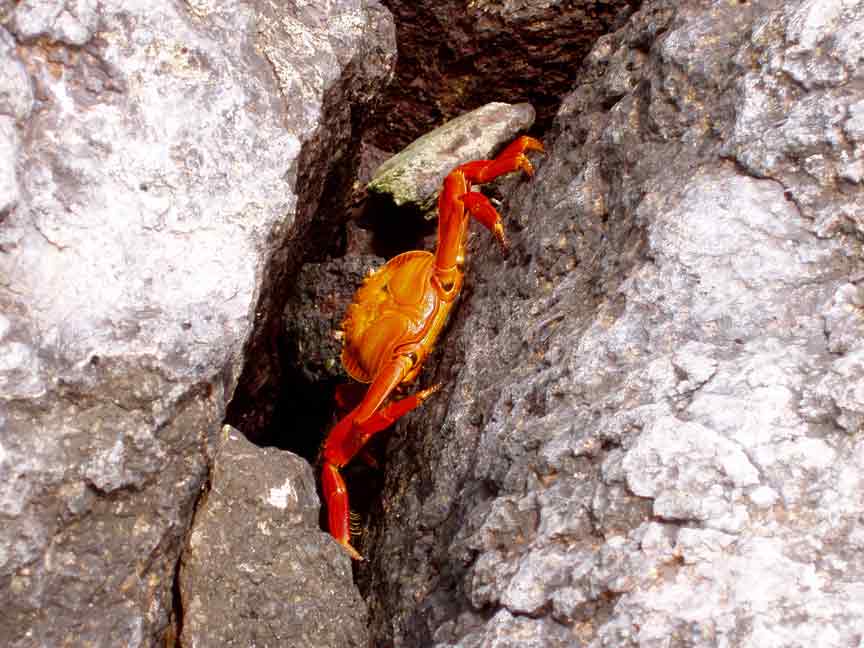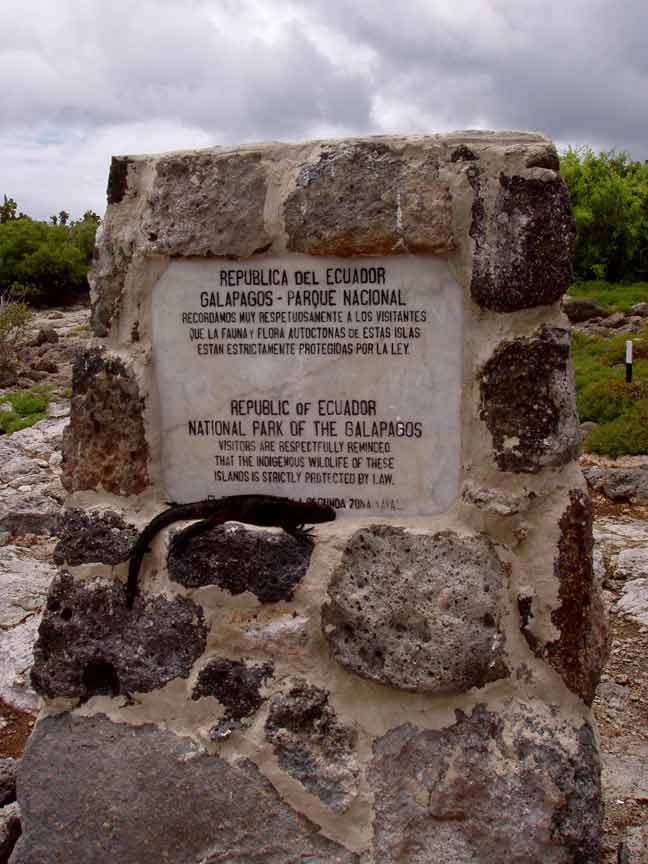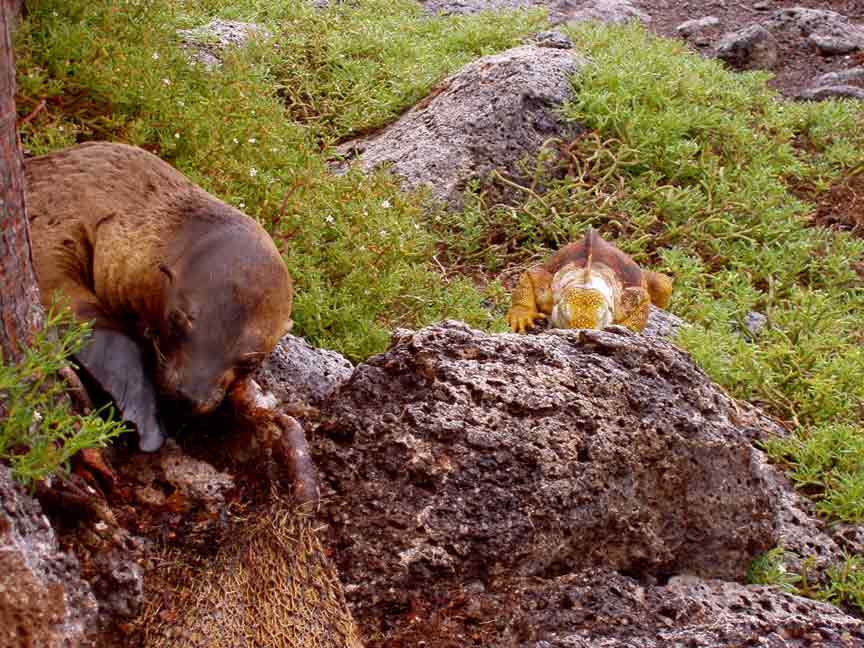Galapagos - South Plaza Island Tour

Harmonie
Don and Anne Myers
Sun 9 Mar 2008 13:40
|
00:44.827S 90:18.414W
Wednesday (3/5) was our third and last Galapagos
tour. This time we were back on the port-listing, tired-looking,
diesel-sucking motorslog mobile (boat) with the Spanglish speaking guide.
We went through the planes, trains and automobiles routine again to reach
our floating chariot. At least this time the starting hour was
reasonable at 8:15am (us retired people can't be expected to rise and shine
too early). The trip to South Plaza Island didn't take too long, even in
our slow boat, because the small island is just off the east coast of Santa
Cruz.
We arrived at South Plaza and hopped in the dinghy
to go ashore. Once our Spanglish guide shooed the sea lions away from our
landing spot, we scrambled onto the narrow jetty and were greeted by so
much wildlife that we didn't move from the 'entrance area' for a good twenty
minutes or so. The first wildlife wonder was the baby sea
lion. According to our guide (and we believe him on this one because
he was very clear) the baby in picture 1 is only one week old. Isn't
it the cutest?? You can't see its mom in the picture,
but the baby was snuggled up close to her. We were also greeted by
hundreds of crabs. One of which is shown in picture 2. These red
crabs cover the black volcanic rocks on the shores of all the
Galapagos islands we've seen. Our guide said something about the crabs
being used to treat the same affliction that Viagra is used for, but we can't be
entirely sure about this. All we know is that the word 'Viagra' was very
clear, and it was mentioned in the same sentence with the
word 'crabs'.
A few steps from the jetty, we ran into the sign
shown in picture 3. In case you can't read the English words at
the bottom, it reads, 'Republic of Ecuador National Park of the Galapagos.
Visitors are respectfully reminded that the indigenous wildlife of these islands
is strictly protected by law.' To drive this point home, one of the
indigenous species known to be unique to the Galapagos, the marine (swimming)
iguana, stationed itself perfectly on the ledge of the sign for all to
see. A literal poster child for the indigenous species of the
Galapagos.
If you haven't noticed already from the previous
day tour pictures, each Galapagos island is different not only in the species of
iguanas and other animals that dwell upon them (which of course is the
phenomena that first intrigued Darwin and led him to his theory of evolution),
but in the vegetation as well. Although we haven't experienced it in the
last week (it's been raining quite a bit, which has resulted in swarms
of ferocious mosquitoes), the climate here is quite dry and different kinds
of cactus flourish on the various islands. The cactus shown in picture 4
is actually a 'female' cactus. The Galapagos have several plants and trees
that have a male and a female version. In each case the female version is
much prettier (of course).
Picture 5 is yet another oversized iguana.
This one seems quite happy to have his? her? picture taken and is smiling for
the camera.
Picture 6 is, according to our guide, so I'm not
completely sure about this one, a sea sparrow. He said they are nocturnal
(yet this one is wide awake in the light of day?) and are known for hanging out
with boats and fishing through the night, disappearing at dawn.
Hmmmmm, perhaps this is one of our friends that kept us company on night watch
during our motorslog?
Picture 7 is my personal favorite. The sea
lions turn a nice golden yellow color when they dry in the sun and this one is
enjoying a nap right next to a matching yellow napping iguana.
One thing you may have noticed based on all of
these pictures is that we, as camera-wielding, picture-taking humans, are
able to get extremely close to all of these animals without scaring them
off. This is something Darwin noted on his first visit, the animals are
simply not afraid of humans. It's not necessarily encouraged (we were
asked to keep a respectful distance from the animals) but anyone could
easily get close enough to touch the animals. Simply amazing. And
it's amazing how fast, as camera-wielding, picture-taking humans, we get used to
this benefit. When we leave this fairy tale and get back to the real
world, it's going to be a big letdown when wildlife we are trying to
photograph can't get away from us fast enough.
After hiking around the island of South Plaza a bit
longer, we headed back to the port-listing, tired-looking, diesel-sucking
motorslog boat, had a nice lunch (fresh shrimp and vegetables, yum), discussed
the merits of the universal 'mom rule' (You must wait one hour after eating to
go swimming - it's amazing how the Germans, English, Australians and
Americans all grew up with the same mom rule. I think it's a
world-wide mom conspiracy.), and flopped into the water with our snorkeling
gear a mere 15 minutes after eating. Sorry moms.
The snorkeling was ok, but after the wonder
of our Floreana trip, it dimmed in comparison. A half-hour or so later, we were summoned back to the boat and
taken directly (yea! no planes, trains and automobiles) back to Academy
Bay where our boats were patiently waiting for us to pay them some
attention.
And so ended our last Galapagos day
tour.
Anne
|






